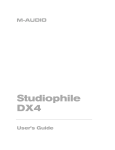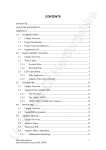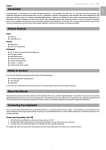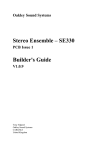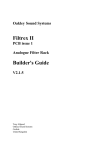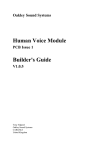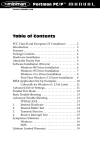Download Table of Contents Flying Cow™ MANUAL
Transcript
1 Flying Cow ™ MANUAL version: FC-042799 Table of Contents FCC Class B and CE Compliance . . . . . . . . . . . . . . . . . . . . . . . .2 Overview . . . . . . . . . . . . . . . . . . . . . . . . . . . . . . . . . . . . . . . . . . . .3 Features . . . . . . . . . . . . . . . . . . . . . . . . . . . . . . . . . . . . . . . . . . . . .4 D/A Converter . . . . . . . . . . . . . . . . . . . . . . . . . . . . . . . . . . . .4 A/D Converter . . . . . . . . . . . . . . . . . . . . . . . . . . . . . . . . . . . .4 Front Panel . . . . . . . . . . . . . . . . . . . . . . . . . . . . . . . . . . . . . . . .4 Panels - Fig. 1 . . . . . . . . . . . . . . . . . . . . . . . . . . . . . . . . . . . . . . . . .5 Panel Description . . . . . . . . . . . . . . . . . . . . . . . . . . . . . . . . . . . . .6 Front Panel . . . . . . . . . . . . . . . . . . . . . . . . . . . . . . . . . . . . . . . .6 Rear Panel . . . . . . . . . . . . . . . . . . . . . . . . . . . . . . . . . . . . . . . .7 Installation and Typical Setup . . . . . . . . . . . . . . . . . . . . . . . . . . .8 Typical Setup - Fig. 2 . . . . . . . . . . . . . . . . . . . . . . . . . . . . . . . . . . .9 Operation . . . . . . . . . . . . . . . . . . . . . . . . . . . . . . . . . . . . . . . . . . .10 Selecting Modes . . . . . . . . . . . . . . . . . . . . . . . . . . . . . . . . . . .10 D/A Operation . . . . . . . . . . . . . . . . . . . . . . . . . . . . . . . . . . .10 A/D Operation . . . . . . . . . . . . . . . . . . . . . . . . . . . . . . . . . . .11 Troubleshooting . . . . . . . . . . . . . . . . . . . . . . . . . . . . . . . . . . . . . .14 Appendix A - Specifications . . . . . . . . . . . . . . . . . . . . . . . . . . . .16 S/PDIF Loopback Test . . . . . . . . . . . . . . . . . . . . . . . . . . . . .17 AES/EBU Loopback Test . . . . . . . . . . . . . . . . . . . . . . . . . . .17 Appendix C - Block Diagram . . . . . . . . . . . . . . . . . . . . . . . . . . .18 Appendix D - Grounding . . . . . . . . . . . . . . . . . . . . . . . . . . . . . .19 Lifetime Limited Warranty . . . . . . . . . . . . . . . . . . . . . . . . . . . . .20 1 FCC Class B and CE Compliance WARNING: This equipment has been tested and found to comply with the limits for a CLASS B digital device, pursuant to Part 15 of the FCC Rules. These limits are designed to provide reasonable protection against harmful interference in a residential installation. This equipment generates, uses and can radiate radio frequency energy and, if not installed and used in accordance with the instructions contained in this manual, may cause harmful interference to radio and television communications. However, there is no guarantee that interference will not occur in a particular installation. If this equipment does cause harmful interference to radio or television reception, which can be determined by turning the equipment off and on, the user is encouraged to try to correct the interference by one or more of the following measures: 1) reorient or relocate the receiving antenna; 2) increase the separation between the equipment and the receiver; 3) connect the equipment into an outlet on a circuit different from that of the receiver; 4) consult the dealer or an experienced audio television technician. NOTE: Connecting this device to peripheral devices that do not comply with CLASS B requirements or using an unshielded peripheral data cable could also result in harmful interference to radio or television reception. The user is cautioned that any changes or modifications not expressly approved by the party responsible for compliance could void the user’s authority to operate this equipment. To ensure that the use of this product does not contribute to interference, it is necessary to use shielded I/O cables. This product also complies with European CE requirements. 2 Overview Thanks for choosing the Flying Cow, professional external digital audio converter box. The unit provides high quality, 24-bit A/D and D/A converters and supports the popular digital audio formats S/PDIF and AES/EBU. The Flying Cow’s unique design allows it to fit into half of a standard 19” rack space — two Flying Cows may be mounted side by side in a single 19” rack space! The Flying Cow is a perfect companion for computer digital I/O cards, or any other digital audio device that requires high-quality A/D and/or D/A conversion. It can even be used as a replacement for lower performance DAT or DVD converters. This manual assumes that you have a basic understanding of A/D and D/A conversion, and digital audio. If after reading this manual you need additional technical support or if you have comments or suggestions, we invite you to contact us directly by any one of the following methods: MIDIMAN 45 E. Saint Joseph Street Arcadia CA 91006-2861 Technical Assistance: Fax: Sales: Internet Tech Support: (626) 445-8495 (626) 445-7564 (626) 445-2842 [email protected] Internet: Web Site: Tech Support: Sales Info: http://www.midiman.net [email protected] [email protected] 3 Features • • • • • • • • • Pro quality, stereo A/D and D/A converters. Simultaneous A/D and D/A conversion. Standard single height, half-rack dimensions. AES/EBU digital I/O on XLR connectors. S/PDIF digital I/O on RCA connectors. Balanced analog inputs on either XLR or 1/4” tip-ring-sleeve connectors. Unbalanced analog inputs on 1/4” tip-sleeve connectors. Balanced analog outputs on XLR connectors. Unbalanced analog outputs on 1/4” connectors. D/A Converter • • • • 24-bit stereo D/A, delta-sigma converters with 128x oversampling. Dynamic range of 104dB (A-weighted). THD = 0.001% @ 0dBFS. Frequency Response:† 20Hz-22kHz, -0.5,-0.3dB A/D Converter • • • • • 24-bit stereo A/D, delta-sigma converters with 128x oversampling. Dynamic range of 102dB (A-weighted). THD: 0.0015% @ 0dBFS. Frequency Response:† 20Hz-20kHz, -0.5,-0.3dB. Sample Rates:† 32, 44.1, 48 kHz and "EXT". Front Panel • • • • • • Analog Input Level knob allows optimum gain setting of input signal to A/D. Dual LED level ladders accurately depict incoming signal levels to A/D. A/D sample rate adjustable from front panel. “D/A Valid” LED indicates valid incoming digital data. LEDs indicate current digital format and A/D sample rate. Unit remembers system setup even after power-off. 4 9VAC 8. AUDIO D/A VALID R 1. 5 S/P DIF 9. 2. ANALOG OUT AES/ EBU DIGITAL FORMAT 1 L 48 44.1 32 3. EXT A/D SAMPLE RATE R L 5. -3 11. AES /E BU OUT CLIP A/D INPUT LEVEL - 40 - 20 - 10 - 6 10. 4. R L ANALOG IN MODE SELECT IN OUT 0 S/PDIF 12. 13. 6. MAX ANALOG INPUT LEVEL 7. 14. AES /E BU IN POWER 24 BIT FLYING COW™ Panels - Fig. 1 Panel Description Front Panel 1. D/A Valid: This LED indicates valid incoming digital data for the D/A converter. When in AES/EBU mode, this LED lights whenever there is a valid digital signal present at the AES/EBU In jack. When in S/PDIF mode, this LED lights whenever there is a valid digital signal present at the S/PDIF In jack. 2. Digital Format: These two LED’s indicate the current digital interface mode as either AES/EBU (professional) or S/PDIF (consumer). The mode applies to digital data both entering and exiting the Flying Cow. The Digital Format is selected via the Mode Select Button. 3. A/D Sample Rate: These four LED’s indicate the current sample rate in use by the A/D converter (48kHz, 44.1 kHz, 32 kHz, or EXT). The first three are standard sample rates. EXT is a special mode in which A/D conversion is synchronized with the sample rate of some external source. It is often used to sync with less common and non-standard sample rates. 4. Mode Select: Repeatedly pressing this button will cycle through all of the available sample rates and digital formats. When powered up, the Flying Cow will restore the mode and sample rate that was set before the previous power-down. 5. A/D Input Level LED’s: These LED meters indicate the left and right analog audio levels entering the A/D converter. CLIP indicates an overload condition to the A/D channel and will result in distortion. 6. Analog Input Level: This knob sets the level of the incoming analog audio signal as it enters the A/D converter. For the greatest dynamic range (and signal-to-noise ratio), it is best to set these levels as high as possible without making the CLIP LED’s light. When turned all the way down (0) attenuation is full, and when turned all the way up (Max) gain is maximum. 7. Power: When this button is in, power is applied to the unit. When out, power is off. When power is turned off, the Digital Format and A/D Sample Rate settings are saved, and restored upon power up. 6 Rear Panel 8. Power connector: For connection to the unit’s external “wallwart” power supply. The Flying Cow uses an external 8.5 or 9 volt A/C power supply with 1 amp or greater current capacity. 9. Analog Out (Right and Left): These are the analog audio outputs from the Flying Cow’s D/A converters. These unique combination jacks mate with either male XLR-type connectors or 1/4” phone plugs. The XLR (outer) portions of the jacks provide balanced outs. The 1/4” (inner) portions provide unbalanced outs. 10. Analog In (Right and Left): These are the analog audio inputs to the Flying Cow’s A/D converters. These unique combination jacks mate with either male XLR-type connectors or 1/4” phone plugs. The XLR (outer) portions of the jacks are compatible with balanced inputs. The 1/4” (inner) portions are compatible with both balanced (tip-ring-sleeve) and unbalanced (tip-sleeve) inputs. 11. AES/EBU Out: This male XLR jack provides standard AES/EBU digital output from the Flying Cow’s A/D converters. The digital audio signal is stereo, containing both left and right channel data. 12. S/PDIF In: This female RCA jack accepts standard S/PDIF input to the Flying Cow’s D/A converters. The digital audio signal is stereo, containing both left and right channel data. This jack may also be used to accept S/PDIF “Word Clock” to the Flying Cow when operating with EXT sample rate. 13. S/PDIF Out: This female RCA jack provides standard S/PDIF digital output from the Flying Cow’s A/D converters. The digital audio signal is stereo, containing both left and right channel data. 14. AES/EBU In: This female XLR jack accepts standard AES/EBU input to the Flying Cow’s D/A converters. The digital audio signal is stereo, containing both left and right channel data. This jack may also be used to accept AES/EBU “Word Clock” to the Flying Cow when operating with EXT sample rate. 7 Installation and Typical Setup Your Flying Cow box should contain this manual, a “wallwart” power transformer (U.S. customers only) and the Flying Cow unit itself. Please save all packing materials in case you should ever need to ship the unit. The Flying Cow may be operated on any flat surface or it may be installed in a standard 19” rack equipment tray. For installation in a 19” rack tray you will first need to remove the four rubber feet from the unit. Next, left or right justify the Flying Cow in the rack tray. Lastly, tighten the included rack-mount screw, through the rack tray hole, into the single threaded hole on the bottom of the Flying Cow chassis. Plug in the power supply. With the Flying Cow’s power turned off, make your connections to any analog or digital cables you will be using. Next, power up the Flying Cow by pressing the Power button on the front panel. IMPORTANT: Before powering up the Flying Cow, turn down any amplifiers (or mixers) connected to the Flying Cow’s outputs. Since it takes several milliseconds for the Flying Cow to acquire and lock onto an incoming digital signal, there may be a slight “pop” sound while powering up. A typical configuration in which a Flying Cow would be used includes a Flying Cow, a PC based digital I/O card, a mixer and an amplifier/sound system (see Typical Setup figure). Such a configuration could be setup as follows: 1.) the unbalanced stereo audio out of the mixer goes to the 1/4” audio inputs on the Flying Cow, 2.) the S/PDIF out of the digital audio card goes to the S/PDIF In on the Flying Cow, 3.) the S/PDIF in of the digital audio card goes to the S/PDIF Out on the Flying Cow, 4.) the unbalanced Analog Out on the Flying Cow goes to a line level audio in on the amplifier/sound system. 8 Typical Setup - Fig. 2 MIC 1 MIC 2 IN 1 IN 2 3 mon 5L mon 7L mon 9L mon OUT L OUT R 4 mon 6R str 8R str 10R str STR RET SEND RIGHT LEFT SPEAKERS 1 2 HIGH • • • • -15 • • • • • • • • • +15 • -15 • -15 • • • +15 • 0 • • • +6 -15 R • • • • • • +6 00 +20 • -15 • • • • 0 R • • • • • • +6 00 +20 • 00 • • • • Max POWER • • • MI +15 • • • • -15 • • • +15 SEND • • • • 0 • • • +6 R • • • 00 +20 • SEND R • • • • • 0 • • • +6 SEND • • • 00 +20 • 0 TM +8 0 • • R • • • 00 +20 - 20 R GAIN • • • PHONES • L GAIN • POWER AMP CLIP • • • +6 BAL • L • • • • • • • • GAIN 10 7/8 BAL • L • • • XI M 10 CHANNEL MIXER 5/6 • GAIN • +15 • -15 PAN • L • • • • • • LOW +15 RIGHT TAPE OUT STEREO RTN • • • MID SEND • • • • -15 • GAIN • • • • PAN • L • • • • • • +15 • • • • • GAIN • • • • • • • • +15 • -15 PAN • L -15 TAPE IN HIGH • • • LOW +15 0 • MID SEND • • • • • • • • +15 • • • • PAN • • • • • • +15 • -15 LOW SEND • • • • • • LEFT 4 HIGH • • • MID +15 LOW • • • • -15 MID • • • 3 HIGH • • • • • • • MAIN • • • • • • • 00 Max 00 +20 MIXER S/PDIF Out/In DIGITAL AUDIO CARD (Inside PC) S/PDIF In/Out AUDIO In AUDIO Out FLYING COW 9 Operation The A/D and D/A sections of the Flying Cow operate simultaneously, even though you may sometimes choose to use only one or the other at any given time. The A/D and D/A are both set up from the Flying Cow’s front panel. Selecting Modes The Mode Select button is used to select the A/D Sample Rate and the Digital Audio Format. As the Mode Select button is repeatedly pressed, the Flying Cow cycles between the four Sample Rate settings: 48 kHz, 44.1 kHz, 32 kHz, and EXT. After every four presses of the button the Digital Format will also change — between AES/EBU and S/PDIF settings. Therefore, it should never take more than 8 presses of the button to get to your desired setup. As they are changed, the Sample Rate and Digital Format settings are stored inside the Flying Cow. When the Flying Cow is turned off and then back on, these changed settings will be retained. D/A Operation The Flying Cow D/A converter is compatible with 24bit, 20bit, 18bit, and even 16bit digital data — the more bits per data word, the better the dynamic range of the output signal — and therefore, the better the audio quality. The D/A converter receives a continuous digital audio stream from either the AES/EBU In or S/PDIF In jack, depending on the setting of the Digital Format on the Flying Cow’s front panel. The digital data is converted to stereo analog audio, and output through the left and right Analog Out jacks. The Analog Out jacks can accept either XLR connections or 1/4” connections. On the XLR audio out connections, the audio is balanced; on the 1/4” audio out connections, the audio is unbalanced. The D/A does not require you to manually select a sample rate. Instead, it automatically detects the sample rate of the incoming digital audio data and adjusts it accordingly. If a valid digital stream is detected, the front panel “D/A Valid” LED will light. 10 IMPORTANT: For the Flying Cow D/A converter to work properly, the Digital Format must be set to the correct incoming digital format (AES/EBU or S/PDIF). A/D Operation The Flying Cow A/D converter accepts analog audio from the left and right Analog In jacks, using either XLR or 1/4” connections. The XLR audio input connections accept balanced signals. The 1/4” audio input connections accept either balanced (tip-ring-sleeve) or unbalanced (tip-sleeve) signals. The analog signals then pass through the Analog Input Level control and into the A/D converter as balanced signals. Finally, the A/D converter converts the analog data to a digital data stream and outputs it to both the AES/EBU Out and S/PDIF Out jacks simultaneously. IMPORTANT: The same digital data is always present at both the AES/EBU and S/PDIF output jacks. Electrically, both of these signals will always be correct. However, the data format of the audio stream will be correct on one jack but not the other (the data format will match the Flying Cow’s front panel Digital Format setting). In many applications this will not present a problem. However, if it does, you must set the front panel Digital Format to match the digital output standard you will be using. The A/D converter requires three parameters to be set up for proper operation: Digital Format, Input Level, and Sample Rate. From the front panel controls of the Flying Cow, set the Digital Format to match that of the digital output jack of the external equipment to which you are connecting the Flying Cow (see page 10–Selecting Modes). For example, if you are connecting the Flying Cow S/PDIF Out to the S/PDIF In of a PC digital sound card, set the Digital Format to S/PDIF. Input Level should be adjusted for optimum A/D sampling quality. For best conversion, the input signal should have enough amplitude to take advantage of all 24 bits of A/D resolution. In other words, the incoming audio signal should be loud enough to approach the A/D converter’s maximum acceptable (full-scale) signal level. The Analog Input Level adjustment on the Flying Cow’s front panel allows you to attenuate or amplify an incoming signal to properly attain the 11 optimum A/D input level. The Flying Cow front panel A/D Input Level indicators aid in this adjustment. Set the A/D input level knob so that you light as many level indicator LED’s as possible without lighting the red Clip LED’s. When the Clip LED’s light, the audio signal is being “clipped” at the maximum allowable input level of the A/D converter. This may cause extreme distortion and should be avoided. NOTE: For the absolute best results, set the Analog Input Level to full attenuation (“0” setting) and externally adjust the incoming analog signals to reach the -3 dB levels at peak volume. An occasional CLIP reading is sometimes OK — it’s best to let your ears be the judge! The A/D Sample Rate should be set according to your application’s needs (see page 10–Selecting Modes). The higher the sample rate, the better the audio quality. On the down side, the higher the sample rate, the more digital data has to be stored per second. Quite often, the sample rate you select for the Flying Cow will be dictated by the sample rates accepted by other components in the system such as sound cards, digital audio workstations, CD players, and DAT machines. The Flying Cow supports three standard sample rates: 48 kHz: In the past, this sample rate was reserved for the most costly professional systems. Today it’s even supported by computer sound cards and many software applications. 48 kHz will achieve the highest fidelity conversion at the expense, however, of requiring more storage space per second of recording (if saved to a disk drive, DAT cartridge, etc.). 44.1 kHz: Historically this has been the most commonly used sample rate because it is the current consumer CD audio sample rate (a.k.a. “redbook audio”). It strikes a good balance between sound quality and storage requirements. 32 kHz: Used for lower-fidelity conversion and utilized mostly in applications that have limited storage space. Frequency response is similar to a mid-priced cassette deck, but signal-to-noise ratio is much higher than any analog tape deck. 12 The Flying Cow also supports synchronization to an external source. The EXT sample rate setting locks the A/D sample rate to a valid AES/EBU or S/PDIF signal received at the digital audio inputs at the back of the unit. This is obviously useful for synchronization. A less obvious application is to use the external sample rate to generate a non-standard or less common sample rate (i.e. other than 48 kHz, 44.1 kHz, or 32 kHz). VERY IMPORTANT: In order to successfully use EXT mode, the following requirements must be met: 1.) the Flying Cow’s A/D Sample Rate must be set to EXT mode, 2.) the Flying Cow’s Digital Format setting must match the digital input jack that is to receive the “sync to” data (AES/EBU In or S/PDIF In) and 3.) a valid digital data stream must be present at that selected digital input. NOTE: If you have set the Sample Rate to EXT, and a valid digital audio signal is being received at the input selected by the Digital Format LED’s (AES/EBU or S/PDIF), the “D/A Valid” LED will light. If the “D/A Valid” LED does not light then either the Digital Format is not set to the proper digital audio format or a valid digital audio signal is not reaching the appropriate digital audio in. NOTE: When the A/D is in EXT mode the D/A converter continues to function normally (i.e. the digital data stream being input to the D/A–the EXT “sync to” data in this case–will be decoded by the D/A and analog audio will be output). 13 Troubleshooting Symptom: Solution: Symptom: Solution: Symptom: Solution: Symptom: Solution 1: Solution 2: Symptom: Solution 1: Solution 2: When power is applied, there are no LED’s lit on the Flying Cow’s front panel. Make sure the power supply is properly plugged into the unit and also into a live wall source. Also make sure the Power button is pushed in (and latched). When changing modes from the front panel, small bursts of noise are sometimes present. This is a normal and is the result of AES/EBU and S/PDIF receivers and transmitters taking a small amount of time to lock onto a new clock frequency or digital audio source. Using a tip-ring-sleeve 1/4” cable, I can’t seem to get balanced analog audio out of the Flying Cow. The analog outputs are balanced only on the XLR connections. The 1/4” analog output connections are unbalanced. When applying a digital signal to the Flying Cow, the “D/A Valid” LED never lights. Make sure the front panel Digital Format is set to match the digital audio format (AES/EBU or S/PDIF) you are inputting to the Flying Cow. The digital signal may be invalid or the cable going to the digital audio in may be faulty. Valid digital data is coming into one of the digital audio inputs (the “D/A Valid” LED is lit), but there is no audible D/A output. Check your analog output connections from the Flying Cow. The digital data source may be sending a static (non-changing or DC) signal. The digital audio stream is valid but the data is not changing. Or the data represents an extremely small waveform that you are unable to hear. 14 Symptom: Solution 1: Solution 2: Symptom: Solution 1: Solution 2: Symptom: Solution: Even though the front panel Analog Input Level knob is set to the MAX setting, none of the Input Level LED’s light. Check your source signal and analog input cables. The input signal is too weak. Turn up the volume of the source — the lower you can set the Analog Input Level knob the better the signal-to-noise performance achieved. Even though the front panel Analog Input Level knob is turned all the way down (0), all of the Input Level LED’s and even the CLIP LED often light. Check your source signal and analog input cables. The input signal is too strong. Reduce the volume of the source and try to keep the Analog Input Level knob set to “0” if possible. This will achieve optimum signal-to-noise performance. With the A/D in EXT mode, the Flying Cow is outputting erroneous digital data even though I think there is a valid digital audio signal coming into the unit. The “D/A Valid” LED does not light. If the “D/A Valid” LED does not light then: 1.) the Digital Format is not set to the proper digital audio format, OR 2.) a valid digital audio signal is not reaching the correct digital audio in. This could happen if you are using the wrong digital audio in or if the digital audio cable is bad or if the device you are using to produce the sync signal is malfunctioning. If any of these mishaps have occurred then the “D/A Valid” LED will not light and the Flying Cow will convert A/D data at a rate that is unpredictable (typically between 10 kHz and 32 kHz). 15 Symptom: Solution: Symptom: Solution: With the A/D in EXT mode, the Flying Cow is outputting digital data even though there is no signal present at the AES/EBU In or S/PDIF In connectors . The “D/A Valid” LED does not light. Even without an external sync source present the Flying Cow will convert A/D data. The sample rate is unpredictable but is usually somewhere between 10 kHz and 32 kHz. I can’t seem to get a good signal to the A/D when I plug one or more balanced, lo-Z microphone(s) into the XLR ports of the Analog In jack(s). A microphone preamp, such as Midiman’s AUDIO BUDDY, is required to boost the low-level mic signal to line-level that is compatible with the Flying Cow’s analog inputs. Appendix A - Specifications Power Supply Output: 8.5 Volts to 9 Volts, AC, 1 Amp or greater. A/D Converter 24-bit stereo A/D, delta-sigma converters with 128x oversampling. Dynamic range of 102dB (A-weighted). THD: 0.0015% @ 0dBFS. Frequency Response: 20Hz-20kHz, -0.5,-0.3dB. Sample Rates: 32, 44.1, 48 kHz and "EXT". D/A Converter 24-bit stereo D/A, delta-sigma converters with 128x oversampling. Dynamic range of 104dB (A-weighted). THD = 0.001% @ 0dBFS. Frequency Response: 20Hz-22kHz, -0.5,-0.3dB Signal Levels Analog Output XLR: balanced, +4dBu nominal, +20dBu peak. Analog Input XLR: balanced, +4dBu nominal, +20dBu peak. Analog Output 1/4": unbalanced (TR), -10dBV nominal, +6dBV peak. Analog Input 1/4": unbalanced (TR), -10dBV nominal, +6dBV peak; balanced (TRS) -10dBV nominal, +6dBV peak. 16 Appendix B - Diagnostic Tests The Flying Cow does not have built-in diagnostics but there are a few simple tests you can run to verify its operation. These tests involve connecting a digital output to a digital input and then playing analog audio through the unit. For the audio coming out of the unit to have high fidelity, both the A/D and D/A circuitry in the unit must be working properly. S/PDIF Loopback Test To test for proper S/PDIF operation, use a coaxial cable to connect the S/PDIF Out to the S/PDIF In. From the front panel, set the Digital Format to S/PDIF and the A/D Sample Rate to something other than EXT. (48 kHz sampling rate is recommended for the highest fidelity, though this test should be run once for each of the three standard sample rates). The “D/A Valid” LED should light, indicating that a valid S/PDIF signal is present. To test further apply a known analog signal to the Analog In connectors. Set the Analog Input Level so that the incoming signal is not clipping the A/D converter. Finally, listen to the Analog Out signals and verify that it matches the known incoming signals with no discernible distortion. AES/EBU Loopback Test To test for proper AES/EBU operation, use an XLR cable to connect the AES/EBU Out to the AES/EBU In. From the front panel, set the Digital Format to AES/EBU and the A/D Sample Rate to something other than EXT. (48 kHz sample rate is recommended for the highest fidelity, though this test should be run once for each of the three standard sample rates). The “D/A Valid” LED should light indicating a valid AES/EBU signal is present. To test further, apply a known analog signal to the Analog In connectors. Set the Analog Input Level so that the incoming signal is not clipping the A/D converter. Finally, listen to the Analog Out signals and verify that it matches the known incoming signals with no discernible distortion. 17 Appendix C - Block Diagram LEFT ANALOG INPUT XLR ANALOG INPUT LEVEL 1/4" Digital Format LED Ladder AES/ EBU (changed by Mode Select Switch) S/P DIF Mode Select Switch DIGITAL OUTPUTS RIGHT ANALOG INPUT AES/EBU A/D CONVERTER XLR S/PDIF ANALOG INPUT LEVEL 1/4" LED Ladder Mode Select Switch A/D Sample Rate 48 44.1 32 Extracted Clock DIGITAL INPUTS Mode Select Switch AES/EBU S/PDIF AES/ EBU D/A CONVERTER S/P DIF Digital Format Ext (changed by Mode Select Switch) LEFT ANALOG OUTPUT XLR 1/4" RIGHT ANALOG OUTPUT (changed by Mode Select Switch) XLR 1/4" 18 Appendix D - Grounding Grounding the shield of a digital cable can sometimes be a tricky issue. In the configuration of audio systems, it is important to avoid ground loops and DC current flowing down the shield of the cable that could result when boxes with different ground potentials are connected. Generally, it is good practice to ground the shield to the chassis of the transmitting unit, and connect the shield through a capacitor to chassis ground at the receiver. This is how the Flying Cow is factory configured and should work fine with most systems. However, in some cases it is advantageous to have the ground of two boxes held to the same potential, and the cable shield might be depended upon to make that electrical connection. The Flying Cow provides the option of grounding or “capacitively” coupling to ground with a pair of "ground-lift" jumpers inside the Cow chassis. JP2 is used to ground the shield of the AES/EBU In (digital receiver), and JP5 is used to ground the shield of the AES/EBU Out (digital transmitter). When each jumper is installed, it connects the associated shield directly to ground. When each jumper is removed, it connects the associated shield to ground through a 0.1uF capacitor. Figure 1 shows the location of the jumpers JP2 and JP5 within the Flying Cow chassis. IMPORTANT: The device power for the Flying Cow and all connected devices should be turned off before opening the Cow and changing its ground jumper settings. JP2 JP5 Figure 1 19 Lifetime Limited Warranty MIDIMAN warrants that this product is free of defects in materials and workmanship under normal use so long as the product is owned by the original purchaser and that purchaser has registered his/her ownership of the product by sending in the completed warranty card. In the event that MIDIMAN receives written notice of defects in materials or workmanship from such an original purchaser, MIDIMAN will either replace the product, repair the product, or refund the purchase price at its option. In the event any repair is required, shipment to and from MIDIMAN and a nominal handling charge shall be born by the purchaser. In the event that repair is required, a Return Authorization number must be obtained from MIDIMAN. After this number is obtained, the unit should be shipped back to MIDIMAN in a protective package with a description of the problem and the Return Authorization clearly written on the package. In the event that MIDIMAN determines that the product requires repair because of user misuse or regular wear, it will assess a fair repair or replacement fee. The customer will have the option to pay this fee and have the unit repaired and returned, or not pay this fee and have the unit returned unrepaired. The remedy for breach of this limited warranty shall not include any other damages. MIDIMAN will not be liable for consequential, special, indirect, or similar damages or claims including loss of profit or any other commercial, damage, even if its agents have been advised of the possibility of such damages, and in no event will MIDIMAN’s liability for any damages to the purchaser or any other person exceed the price paid for the product, regardless of any form of the claim. MIDIMAN specifically disclaims all other warranties, expressed or implied. Specifically, MIDIMAN makes no warranty that the product is fit for any particular purpose. This warranty shall be construed, interpreted, and governed by the laws of the state of California. If any provision of this warranty is found void, invalid or unenforceable, it will not affect the validity of the balance of the warranty, which shall remain valid and enforceable according to its terms. In the event any remedy hereunder is determined to have failed of its essential purpose, all limitations of liability and exclusion of damages set forth herein shall remain in full force and effect. 20





















